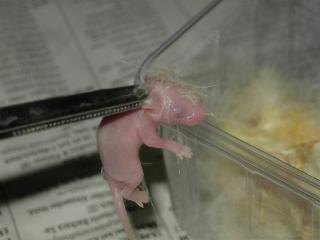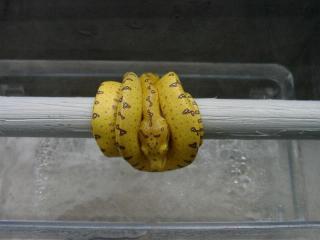 |
|||||||||
|
|
|||||||||
|
|
|||||||||
|
Copyright © since 2000 |
|||||||||
|
|
|||||||||
|
|
It seems, for the first impression, that this handling is cruelty to the young snakes. Due to the reason that they need a very high humidity I made very positive experience of keeping the animals like this. On the other side I have at any time a very good overview of each box. I collect all the little boxes in one large glass enclosure – the heating source is a cable laying at the ground of the enclosure. I use a special control unit for the temperature – in the night its 26° Celsius – within the day its 31° Celsius. |
|
Photo HaraldQ |
|||||
|
Feeding: |
|||||
|
First of all – neonates will be feeded after the first sheeding.
Up to now it was never necessary to feed little Corallus hortulanus forcibly. Over the night they get one little hairy mouse into their box (of course without water). Due to the activities of the mouse the hunting instinct of the snake will be stimulated. Within the night the snake will eat the mouse. This methode was never successful with neonates of Morelia Viridis - it is necessary to stimulate the snakes by moving the really little mouse (only one up to three days old) with a pair of tweezers. Approximately 33% of the little Chondros will take the food – for the others you need more patience. Each three days I would try to feed the little snakes – a good moment could be when the little snakes are watching on their branches and wag their tails. Feeding with „Indianes“ In case that baby mouses do not find interest try to feed “indianes” – “indianes” are prekilled baby mouses with a few feeders at their head. Wash the mouse with warm water so they do not smell like mouses so much – and the feeders will stick on the mouse. Now take the “indian” with the pair of tweezers so that the little snake will touch the mouse with the tip of the tongue. If the snake do not snap you can press the little mouse very carefully against the mouth of neonate. With a little luck and patience the snake takes now the mouse – maybe it is necessary to pull a little bite at the mouse before the snake wraps around and starts to eat. Very often its enough to rub the mouse at the feeders of the chicken.
|
 |
|
|
|
Reflex Feeding Another very successful methode is to pull the baby mouse so often against the little snake until it became angry and bits. In best case the neonate starts to eat. Each trial should not take to long – its better to try it several times with a break between. My experience is that very often the mouse has been taken immidiately after a break.
Forcible Feeding At any time the forcible feeding should be the last step. In case that all other methods and efforts within several weeks showed no success there is no other possibility. Sometimes it is enough to take the prekilled little mouse and stuff it into the mouth of the snake. Now put the snake back into the box. In most cases they swallow down the mouse. If this do not work we have to help the snake very carefully with a massage – from the head down to the stomach. During this procedure the snake is cramped and open the mouth wide. A signale that the snake calms down is when they start leap up. Now you have to return the snake to their favorite place. Further information or tipps I don’t want to explain – each of you should have one special snake book at home where you can find additional information. Periode of feeding and intestine incident Baby snakes will be feeded once a week. Morelia viridis inclined to intestine incident in the first year. In most cases the breaders don’t talk about this problem. Intestine incident is caused – that is my opinion - by too frequent feeding and the thereby resulting frequent setting excrements. It is better to feed Morelia viridis only all 10 days – the sice of the food should be in relation to the sice of the body. In case of a intestine incident the intestine should be returned as soon as possible with a probe (use the same probe you take for sex regulation). Press one finger at the cloaca before you return the snake to the enclosure. Now observe the animal for a while – very often the intestine will be squeezes out again. Now you have to repeat everything again and put a tape at the cloaca. I suggest a feeding break of 4 weeks. A intestine incident looks dangerous and not very nice, usually the problem can be solved without any durably damage for the snake. |
|
Ignored Sheeding Specially with the yellow neonates of Morelia viridis it is difficult to notice the forthcoming sheeding. With the time on everyone will get experience to see when the skin get some folds – the sheeding of little Morelia viridis will have the same interval how the feeding. By feeding at this time it is possible that the little snakes by digesting sleep run over the sheeding. If you notice that you have to keep the snakes wet – the humidity is now approximately 99%. If you expect the next sheeding stop early enough the feeding – it is no problem for the snakes to have a feeding break of three weeks. In general the snakes strip of the skins without any problems. |


